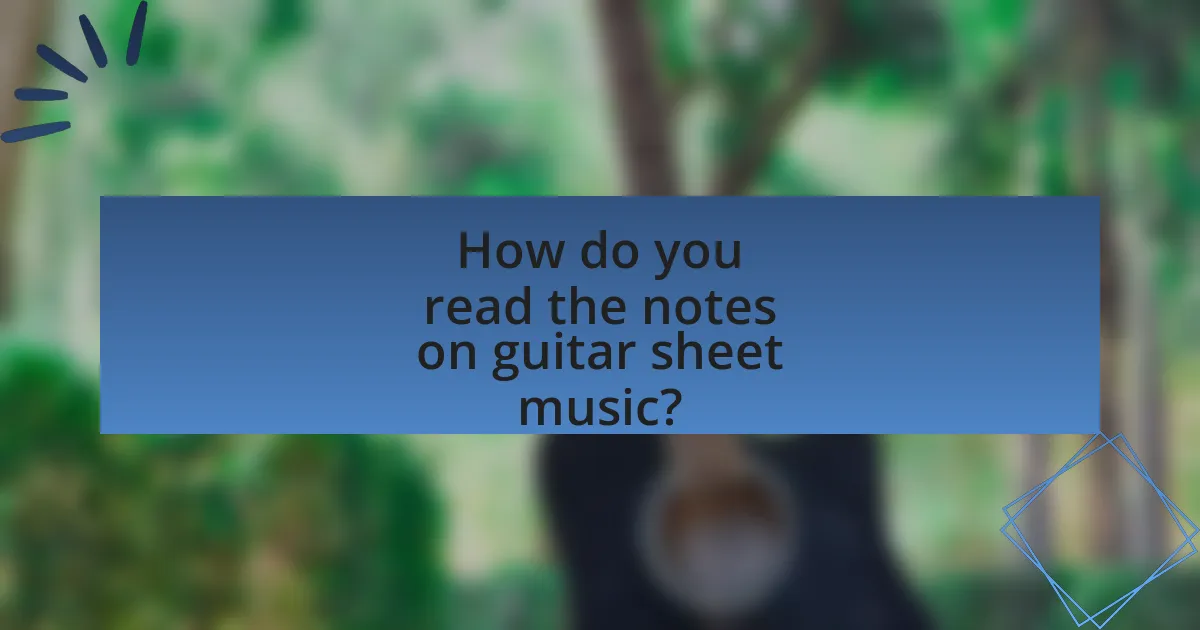Guitar sheet music is a specialized form of music notation designed for guitarists, incorporating both standard notation and tablature to facilitate accurate performance. This article explores the distinctions between guitar sheet music and other notation types, emphasizing the importance of music theory in reading and interpreting music effectively. Key elements such as notes, rhythms, key signatures, and time signatures are outlined, along with techniques for improving sight-reading skills and overcoming common challenges faced by guitarists. Additionally, best practices for maintaining focus and accuracy while reading sheet music are discussed, providing a comprehensive guide for musicians seeking to enhance their proficiency in reading guitar music.

What is Guitar Sheet Music?
Guitar sheet music is a written representation of music specifically for the guitar, indicating notes, rhythms, and other musical instructions. It typically includes standard notation, tablature, or a combination of both, allowing guitarists to interpret and perform pieces accurately. The use of guitar sheet music dates back to the Renaissance, where early forms of notation were developed for string instruments, establishing a foundation for modern guitar music.
How is guitar sheet music different from other types of music notation?
Guitar sheet music differs from other types of music notation primarily in its use of tablature alongside standard notation. Tablature, or “tab,” visually represents the guitar fretboard, indicating which fret to press on which string, making it more accessible for guitarists who may not read traditional sheet music. This dual approach allows guitarists to quickly learn songs without needing extensive music theory knowledge, as evidenced by the popularity of tab in online music communities and instructional materials. Additionally, guitar sheet music often includes chord diagrams and finger positioning, which are less common in notation for other instruments, further catering to the specific needs of guitar players.
What are the key elements of guitar sheet music?
The key elements of guitar sheet music include the staff, notes, clefs, time signatures, key signatures, and tablature. The staff consists of five lines and four spaces where notes are placed to indicate pitch. Notes represent specific sounds and their duration, while the treble clef is commonly used for guitar music to denote the pitch range. Time signatures indicate the rhythm and beat of the piece, and key signatures define the scale and tonal center. Tablature provides a visual representation of finger placement on the guitar fretboard, making it easier for players to understand how to play the music. These elements collectively enable musicians to interpret and perform guitar music accurately.
How does guitar tablature complement standard notation?
Guitar tablature complements standard notation by providing a visual representation of finger placement on the guitar, making it easier for players to learn and play music. While standard notation indicates pitch and rhythm, tablature specifies which strings and frets to use, allowing guitarists to quickly grasp the mechanics of playing a piece. This dual approach caters to different learning styles; some musicians may find tablature more intuitive, especially beginners, while others may prefer the comprehensive musical context offered by standard notation. The combination of both systems enhances overall understanding and performance, as evidenced by the widespread use of both methods in instructional materials and sheet music for guitar.
Why is understanding music theory important for reading guitar sheet music?
Understanding music theory is important for reading guitar sheet music because it provides the foundational knowledge necessary to interpret musical symbols and structures effectively. Music theory explains how notes, rhythms, scales, and chords function, enabling guitarists to recognize patterns and relationships within the music. For instance, knowing how to read key signatures helps musicians identify the tonal center of a piece, while understanding time signatures allows them to grasp the rhythmic framework. This knowledge enhances a guitarist’s ability to play accurately and expressively, as they can anticipate changes and make informed musical decisions.
What fundamental music theory concepts should every guitarist know?
Every guitarist should know the concepts of scales, chords, intervals, and key signatures. Scales form the foundation of melodies and improvisation, with the major and minor scales being the most fundamental. Chords, which are built from scales, provide harmonic support and structure to music; understanding major, minor, and seventh chords is essential. Intervals, the distance between two notes, are crucial for recognizing melodies and harmonies, while key signatures indicate the tonal center of a piece, guiding the guitarist in understanding the music’s structure. Mastery of these concepts enables guitarists to read sheet music effectively and enhances their overall musicianship.
How does music theory enhance the ability to interpret sheet music?
Music theory enhances the ability to interpret sheet music by providing a structured understanding of musical elements such as notes, rhythms, scales, and harmony. This foundational knowledge allows musicians to decode the symbols on the page, facilitating quicker and more accurate performance. For instance, recognizing time signatures helps musicians understand the rhythmic framework of a piece, while knowledge of key signatures aids in identifying the tonal center and the associated sharps or flats. Studies have shown that musicians with a solid grasp of music theory can sight-read more effectively, as they can anticipate musical patterns and relationships, leading to improved overall musicality and expression.

How do you read the notes on guitar sheet music?
To read the notes on guitar sheet music, first identify the staff, which consists of five lines and four spaces where notes are placed. Each line and space corresponds to a specific note, with the bottom line representing E and the top line representing F in standard tuning. Additionally, guitar sheet music often uses a treble clef, indicating that the notes are played in a higher pitch range.
Notes on the staff can be further understood by recognizing that the notes on the lines from bottom to top are E, G, B, D, and F, while the notes in the spaces are F, A, C, and E. Furthermore, guitar sheet music may include tablature, which visually represents the strings and frets, providing an alternative method to interpret the music. This dual representation allows guitarists to easily translate written music into playable notes on the instrument.
What are the different types of notes and their values?
The different types of notes in music include whole notes, half notes, quarter notes, eighth notes, and sixteenth notes, each with specific values. A whole note is held for four beats, a half note for two beats, a quarter note for one beat, an eighth note for half a beat, and a sixteenth note for a quarter of a beat. These values are fundamental in music notation, allowing musicians to understand the duration of each note in relation to the tempo and rhythm of a piece.
How do note durations affect guitar playing?
Note durations significantly influence guitar playing by determining the timing and rhythm of notes played. For instance, longer note durations, such as whole notes or half notes, require sustained finger positions and can create a more melodic and flowing sound, while shorter note durations, like eighth or sixteenth notes, demand quicker finger movements and precise timing to maintain rhythm. This relationship between note duration and playing technique is essential for interpreting sheet music accurately, as it dictates how musicians express dynamics and phrasing. In practice, guitarists must adapt their strumming or picking techniques based on the note durations indicated in the sheet music to achieve the intended musical effect.
What symbols indicate dynamics and articulation in guitar music?
Symbols that indicate dynamics and articulation in guitar music include markings such as “p” for piano (soft), “f” for forte (loud), “mf” for mezzo-forte (moderately loud), and “pp” for pianissimo (very soft). Additionally, articulation symbols like staccato (a dot above or below a note), legato (a slur connecting notes), and accents (a > symbol above a note) provide specific instructions on how to play the notes with varying intensity and style. These symbols are standardized in musical notation, allowing guitarists to interpret the intended expression and dynamics of a piece accurately.
How do you identify the key signature and time signature?
To identify the key signature, examine the sharps or flats located at the beginning of a piece of music, immediately after the clef. Each sharp or flat corresponds to a specific note, determining the key of the piece. For example, one sharp indicates the key of G major or E minor, while one flat indicates F major or D minor.
To identify the time signature, look for the two numbers at the beginning of the staff, following the clef and key signature. The top number indicates how many beats are in each measure, while the bottom number indicates the note value that receives one beat. For instance, a time signature of 4/4 means there are four beats per measure, and a quarter note gets one beat.
These methods are standard practices in music theory, allowing musicians to quickly ascertain the structure and tonality of a piece.
What role does the key signature play in guitar music?
The key signature in guitar music indicates the scale and tonal center of a piece, guiding the guitarist on which notes are sharp or flat throughout the composition. This information is crucial for interpreting the music correctly, as it establishes the harmonic framework and influences chord choices and finger positioning. For example, a key signature of one sharp indicates the key of G major or E minor, which informs the guitarist about the prevalent notes and chords to use, ensuring accurate performance and adherence to the intended sound of the piece.
How does the time signature influence rhythm and strumming patterns?
The time signature directly influences rhythm and strumming patterns by determining the number of beats in each measure and the note value that receives one beat. For example, a 4/4 time signature indicates four beats per measure, allowing for a steady, even strumming pattern that can accommodate various rhythms, such as downstrokes on each beat or syncopated patterns. In contrast, a 3/4 time signature, which has three beats per measure, typically leads to a waltz-like rhythm, often resulting in a strumming pattern that emphasizes the first beat, creating a different feel and flow in the music. This structural framework provided by the time signature shapes how musicians approach rhythm and strumming, guiding their choices in creating cohesive and stylistically appropriate music.

What techniques can improve your ability to read guitar sheet music?
To improve your ability to read guitar sheet music, practice regularly with sight-reading exercises. Sight-reading enhances your ability to quickly interpret notes and rhythms, which is essential for effective music reading. Research indicates that consistent practice, such as playing through new pieces daily, significantly increases reading proficiency. Additionally, using a metronome can help maintain a steady tempo, allowing you to focus on note accuracy without getting overwhelmed by speed. Engaging with various musical styles also broadens your familiarity with different notations and rhythms, further enhancing your reading skills.
How can practice routines enhance sheet music reading skills?
Practice routines enhance sheet music reading skills by providing structured and consistent exposure to musical notation. Regular practice allows musicians to familiarize themselves with various symbols, rhythms, and dynamics, leading to improved recognition and interpretation of sheet music. Studies indicate that consistent practice can increase sight-reading proficiency, as evidenced by research conducted by the University of Southern California, which found that musicians who engaged in daily sight-reading exercises showed a 30% improvement in their reading speed and accuracy over a six-month period. This structured approach not only builds muscle memory but also reinforces cognitive associations between notes and their corresponding sounds, ultimately leading to greater fluency in reading sheet music.
What exercises are effective for improving sight-reading?
Effective exercises for improving sight-reading include practicing scales, sight-reading from a variety of sheet music, and using rhythm exercises. Practicing scales helps musicians become familiar with note patterns and finger placements, enhancing their ability to read music quickly. Sight-reading from diverse genres exposes musicians to different musical styles and complexities, which builds adaptability and confidence. Rhythm exercises, such as clapping or tapping out rhythms before playing, reinforce timing and help musicians internalize rhythmic patterns, further aiding sight-reading skills. These exercises collectively contribute to a musician’s overall proficiency in sight-reading.
How can playing along with recordings aid in understanding sheet music?
Playing along with recordings significantly enhances the understanding of sheet music by providing a real-time auditory reference that aligns with the written notes. This practice allows musicians to connect the visual representation of music on the page with the actual sound produced, reinforcing note recognition, rhythm, and dynamics. Research indicates that auditory feedback from recordings helps in internalizing musical phrases and structures, making it easier to interpret and perform sheet music accurately. By engaging with recordings, musicians can also develop a better sense of timing and phrasing, which are crucial for effective performance.
What common challenges do guitarists face when reading sheet music?
Guitarists commonly face challenges such as interpreting musical notation, understanding rhythm, and translating sheet music to finger placement on the fretboard. Interpreting musical notation can be difficult due to the complexity of symbols and the need to recognize notes quickly. Understanding rhythm poses a challenge as guitarists must accurately read and execute various time signatures and note values. Additionally, translating sheet music to finger placement requires a solid grasp of the fretboard, which can be overwhelming for beginners. These challenges are supported by studies indicating that many musicians struggle with sight-reading, particularly in the context of string instruments, where finger positioning adds an extra layer of complexity.
How can you overcome difficulties with complex rhythms?
To overcome difficulties with complex rhythms, practice breaking them down into smaller, manageable components. Musicians can isolate challenging sections and play them slowly, gradually increasing the tempo as they gain confidence. This method is supported by the principle of chunking in cognitive psychology, which suggests that breaking information into smaller units enhances learning and retention. Additionally, using a metronome can help maintain a steady tempo, allowing musicians to focus on rhythm accuracy. Research indicates that consistent practice with a metronome improves timing and rhythmic precision, essential for mastering complex rhythms.
What strategies help with memorizing pieces from sheet music?
Effective strategies for memorizing pieces from sheet music include breaking the music into smaller sections, using visualization techniques, and employing repetition. Breaking the music into manageable segments allows musicians to focus on mastering each part before integrating them. Visualization techniques, such as imagining the notes and finger placements, enhance memory retention by creating mental images of the music. Repetition solidifies memory through consistent practice, reinforcing neural pathways associated with the piece. Research indicates that spaced repetition, where practice sessions are distributed over time, significantly improves long-term retention of musical pieces.
What are some best practices for reading guitar sheet music effectively?
To read guitar sheet music effectively, musicians should focus on understanding the staff, notes, and rhythms. Familiarity with the treble clef, which is commonly used for guitar music, is essential, as it indicates the pitch of notes. Additionally, recognizing the placement of notes on the staff helps in identifying which strings and frets to play. Practicing sight-reading regularly enhances fluency, allowing musicians to interpret music more quickly. Utilizing a metronome aids in maintaining consistent timing and rhythm, which is crucial for accurate performance. Research indicates that consistent practice and exposure to various musical styles improve overall reading skills, making these methods effective for guitarists.
How can you develop a systematic approach to reading music?
To develop a systematic approach to reading music, start by breaking down the elements of music notation into manageable parts, such as notes, rhythms, and dynamics. This method allows for focused practice on each component, facilitating gradual mastery. For instance, learning to identify notes on the staff can be enhanced through flashcards or apps that reinforce note recognition. Additionally, practicing rhythmic patterns using a metronome helps internalize timing and tempo. Research indicates that systematic practice leads to improved retention and understanding of musical concepts, as evidenced by studies on music education methodologies. By consistently applying this structured approach, musicians can enhance their reading skills effectively.
What tips can help maintain focus and accuracy while reading?
To maintain focus and accuracy while reading guitar sheet music, practice active reading techniques such as previewing the material, breaking it into manageable sections, and minimizing distractions. Active reading involves scanning the sheet music for key elements like time signatures and key signatures before diving into detailed reading, which enhances comprehension and retention. Breaking the material into smaller sections allows for concentrated focus on each part, reducing cognitive overload. Additionally, creating a distraction-free environment, such as a quiet room and using tools like a music stand, can significantly improve focus. Research indicates that minimizing distractions can enhance cognitive performance, as shown in studies on attention and reading comprehension.


